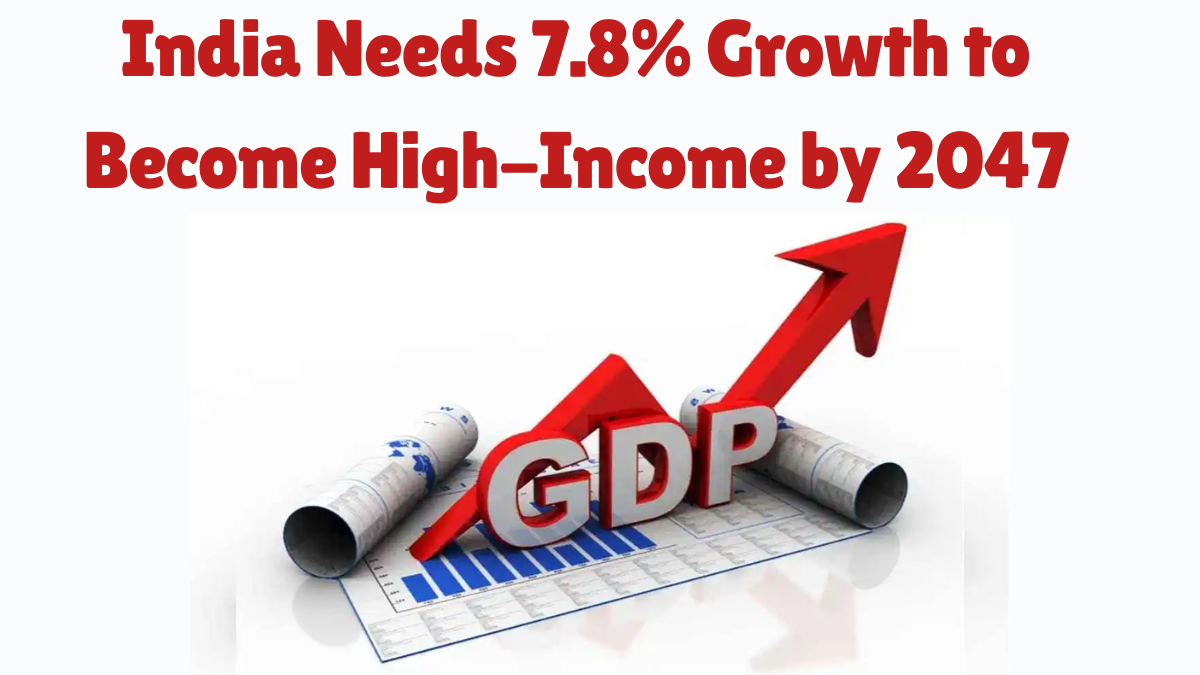India, one of the fastest-growing economies globally, has an opportunity to join the ranks of high-income countries by 2047. However, according to the World Bank, achieving this milestone requires India to sustain an annual growth rate of 7.8% for the next two decades. This target is ambitious, but with the right economic reforms and strategic investments, India could significantly increase its per capita income, create millions of jobs, and lift millions out of poverty.
In this article, we’ll explore what India needs to achieve this goal, the challenges it faces, and the key economic reforms necessary for India to become a high-income country by 2047.

What Defines a High-Income Country?
The World Bank defines a high-income country as one with a Gross National Income (GNI) per capita of $12,536 or more. Currently, India’s GNI per capita stands at around $2,000, meaning it has a long way to go to reach this threshold. To meet the high-income classification, India will need to focus on driving economic growth, increasing productivity, and improving income distribution over the next two decades.
Why Does India Need 7.8% Growth to Achieve High-Income Status?
The World Bank’s forecast suggests that to become a high-income nation by 2047, India must maintain a sustained economic growth rate of 7.8% annually. This ambitious target is necessary to increase per capita income and reduce poverty. The reasons behind this growth rate are multifaceted:
-
India’s Young Workforce: India has one of the youngest populations in the world, with a median age of just 28 years. This demographic advantage can drive the economy forward if the country creates enough jobs and skills to match the growing demand.
-
Increased Urbanization: As India becomes more urbanized, there will be a transition towards higher productivity industries such as manufacturing, services, and technology, which could fuel sustained economic growth.
-
Digital Economy: The rapid adoption of digital technologies like fintech, e-commerce, AI, and cloud computing is opening new avenues for economic growth, productivity, and job creation.
-
Government Reforms: India has implemented significant reforms such as GST, Make in India, and labor reforms, which are designed to foster a business-friendly environment and attract investment.
Challenges India Must Overcome to Achieve 7.8% Growth
1. Infrastructure Gaps
While India has made strides in improving its infrastructure, there are still significant gaps in transportation, energy, and logistics. These deficits result in high business costs and reduced productivity, hampering economic growth. The country needs continued investment in infrastructure to ensure efficient supply chains and reduce operational costs for businesses.
2. Job Creation and Employment
With India’s labor force growing rapidly, creating jobs that match the skills of this workforce is a significant challenge. Currently, millions of young people enter the job market every year, but the labor market is unable to provide sufficient employment opportunities, particularly in the formal sector. To reach 7.8% growth, India must create jobs in both traditional sectors and emerging high-tech industries.
3. Education and Skill Development
While India’s literacy rates have improved, there remains a gap in the quality of education and skills training. Vocational training, along with higher education reforms, is crucial for equipping the workforce with the skills needed to thrive in a modern economy. Skill development will help India transition into high-value industries, including tech, manufacturing, and services.
4. Political and Social Stability
India’s economic growth depends on political stability and social cohesion. Regional disparities, social unrest, and political challenges can derail the progress needed to meet the 7.8% growth target. Ensuring that growth is inclusive and benefits all regions and communities will be key to long-term success.
5. Environmental Sustainability
India must address the growing environmental challenges associated with rapid urbanization and industrialization. Pollution control, resource conservation, and green technologies are critical for balancing economic growth with environmental protection. This will also support sustainable development and ensure long-term growth.
Key Reforms to Achieve Sustainable Growth
1. Strengthening Manufacturing and Export Sectors
The government’s Make in India initiative aims to increase the share of manufacturing in India’s GDP. However, India needs to boost manufacturing capabilities and scale up production in sectors like electronics, renewable energy, and aerospace. A focus on export-led growth will be essential for increasing foreign exchange reserves and driving economic expansion.
2. Investment in Infrastructure Development
To sustain growth, India must continue investing in transportation, logistics, and digital infrastructure. Improving road networks, railways, and energy distribution will increase productivity and lower the cost of doing business. The National Infrastructure Pipeline (NIP) outlines significant investments needed for infrastructure projects, but further investments in key areas are crucial.
3. Labor Market Reforms
Reforming labor laws and improving labor market flexibility is critical to fostering growth. Simplifying labor regulations, increasing worker mobility, and enhancing social security will help create a more dynamic workforce that can meet the demands of a growing economy.
4. Improving Access to Finance
Access to finance remains a major challenge, particularly for small and medium-sized enterprises (SMEs). Strengthening India’s financial sector, increasing credit access, and improving financial inclusion will enable businesses to innovate, grow, and create jobs, fueling the economy.
5. Enhancing Education and Skill Development
Investing in quality education and vocational training will enable India to develop a more skilled workforce. Additionally, fostering entrepreneurship through education will allow more people to contribute to economic growth by creating businesses and innovations.
6. Strengthening Governance and Institutions
India must continue to strengthen its governance and institutional framework. Improving transparency, reducing corruption, and ensuring efficient public administration will foster a more conducive environment for business and investment, which are critical for sustained growth.
Conclusion
India’s ambition to become a high-income country by 2047 is an exciting and achievable goal, but it requires sustained economic growth, structural reforms, and investments across several sectors. With the right combination of policies, India can overcome challenges related to infrastructure, job creation, and education, while making strides towards environmental sustainability.
The 7.8% annual growth rate needed to reach high-income status will require India to focus on manufacturing, innovation, digital transformation, and governance. By fostering an environment conducive to business and growth, India has the potential to join the ranks of high-income countries and improve the living standards of millions of its citizens.
Frequently Asked Questions
1. What is the target growth rate for India to become a high-income country by 2047?
India needs to achieve an average annual growth rate of 7.8% over the next two decades to reach high-income status by 2047, according to the World Bank.
2. What is considered a high-income country?
A high-income country is one with a Gross National Income (GNI) per capita of $12,536 or more. India’s current GNI per capita is around $2,000.
3. What are the key challenges India faces in reaching high-income status?
India faces challenges such as infrastructure deficits, job creation, education and skill gaps, political instability, and environmental sustainability, which must be addressed to achieve high-income status.
4. How can India maintain 7.8% growth annually?
India can sustain growth by focusing on manufacturing, education, infrastructure investment, job creation, and labor reforms. Strengthening digital transformation and fostering a business-friendly environment will also contribute to long-term growth.
5. How will India’s youth contribute to its growth?
India’s young workforce presents a significant opportunity for economic growth. By investing in education, vocational training, and job creation, India can harness its demographic advantage to achieve sustained economic growth.
Click here to learn more.
Pari is a passionate writer known for captivating stories that blend imagination and reality. Inspired by travel, history, and everyday moments, Pari crafts narratives that resonate deeply with readers.
